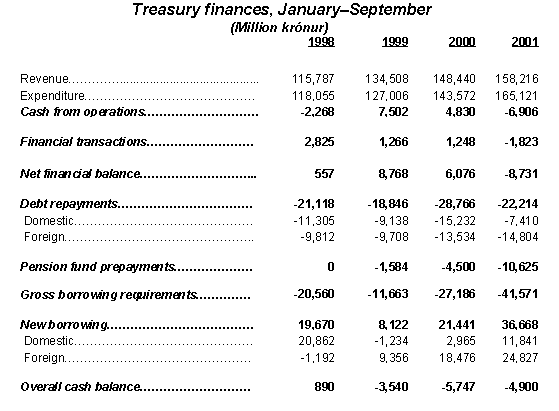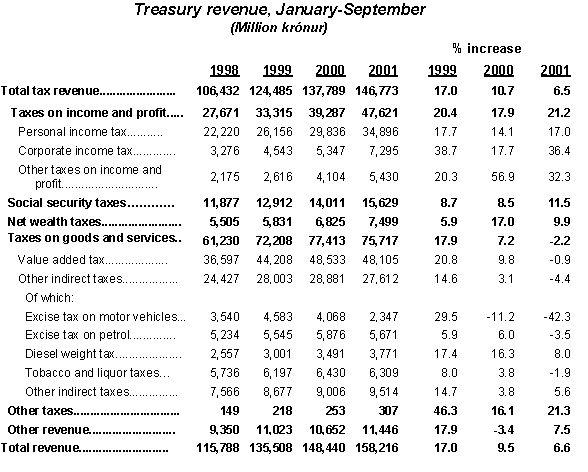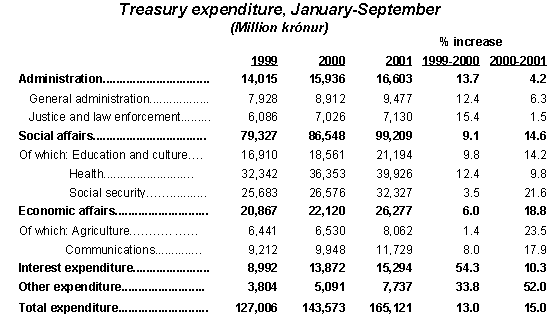Treasury finances in January - September 2001. Report date: October 24, 2001
Treasury Finances, January-September 2001
Report date October 24, 2001
This report is available in PDF form (PDF 26K)
Figures for Treasury finances in the first nine months of the year 2001 are now available. They are presented on a cash basis and are therefore not comparable to the Treasury accounts or the fiscal budget, both of which are presented on an accruals basis.
Summary
The cash deficit from operations amounted to 6.9 billion krónur in the first nine months of the year, compared to a surplus of 4.9 billion krónur a year ago. Total revenue increased by close to 10 billion krónur from last year, due mostly to an increase in income tax collection. The increase in expenditure was considerably larger, and amounted to about 21S billion krónur or 15%. The largest part of the increase is due to the impact of wage agreements and the development of the exchange rate, or about 5 billion krónur. In addition to the aforementioned, payments to the newly created Childbirth Leave Fund caused an increase of 1.7 billion and the increase in payments to the Municipal Equalisation Fund also amounted to 1.7 billion. The rise in interest payments amounted to 1.4 billion and special payments to the disabled to 1.3 billion. Payments by the Treasury to the Social Security Administration on account of increased pension payments amounted to 1 billion and 0.8 billion were spent on the purchase of farm production quotas. It should be noted that a part of this increase will not affect this year's accounts on an accruals basis.

The net financial deficit amounted to 8.7 billion krónur, close to 15 billion krónur below the result for the corresponding period a year earlier. In addition to the expenditure items mentioned above, the larger deficit this year is due to the fact that in the year 2000 the Treasury received a one-time payment of 5.5 billion krónur for the sales of shares in the two state-owned commercial banks. These sales actually took place towards the end of the year 1999 but payments were made in early 2000. A total of 10S billion krónur were paid to the Government Employees Pension Fund in the first nine months of this year. The purpose of this is to reduce the Treasury}s future commitments to the Fund. In all, 15 billion krónur are allocated to this in the 2001 fiscal budget.
The overall cash deficit in the first nine months of the year amounted to 4.9 billion krónur.
Revenue
The Treasury's total revenue amounted to 158 billion krónur in the first nine months of this year. The increase from last year is 9.8 billion krónur, or 6.6 per cent. Tax revenue has increased by a similar percentage, compared to 10S per cent last year and 17 per cent two years ago.

The increase in revenue from last year is largely due to an increase in personal and corporate income taxes as well as in capital income taxes. There are, however, some temporary factors leading to this outcome, the effects of which will subside in the next few months. For example, the increase in personal income tax revenue is largely due to a wage increase based on wage agreements in 2000 plus an additional increase in 2001. In total, taxes on wages and profits and social security taxes are close to 8 billion krónur over projections. Net wealth taxes are, on the other hand, in line with projections.
The slowdown in the economy is clearly reflected in the development of indirect taxes. Revenue from indirect taxes are almost 1.5 billion krónur lower than in the corresponding period last year and more than 6 billion krónur below projections. This development reflects a considerable contraction in real terms, or by 7S per cent. This is mostly due to a substantial decline in private consumption, especially vehicle purchases and other consumer durables such as household appliances. Excise taxes on motor vehicles have declined by more than 40 per cent, or by 1.7 billion krónur. Excise taxes on petrol have also declined. The slowdown is also reflected in declining revenue from the value-added tax, which has declined in absolute terms from the previous year and by about 6 per cent in real terms.
Expenditure
The Treasury's total expenditure amounted to close to 165 billion krónur in the first nine months of the year. Expenditure increased by 21S billion from last year due to several reasons listed in the summary above.

Administrative expenditure increased by close to 700 million krónur, or 4.2 per cent from last year. This is due mostly to a purchase of new information systems for the government at a cost of 450 million krónur, but foreign affairs expenditure have also increased by 400 million since last year. Offsetting this to some degree is a decline in other expenses due to the fact that last year's expenditure included non-recurring expenditure connected with the Christianity millennium celebrations. Total law enforcement expenditure increased by only 100 million krónur despite an increase of 540 million krónur in expenditure on police services and the courts, since payments for avalanche prevention measures declined by 700 million.
Social affairs. Close to 60 per cent of expenditure over this period went to various social affairs, including education, culture, health and social security. Expenditure in this category rose by 12.7 billion krónur from the previous year. Expenditure for education rose by 14.2 per cent, or 2.2 billion krónur, a substantial part of which is due to the increase of 400 million krónur in payments to the Student Loan Fund. It is foreseen that the Fund's loans will increase in excess of projections because of the decline in the króna exchange rate. Payments to the University of Iceland increased by 250 million krónur and payments to higher education and special schools rose by one billion krónur or 19.4 per cent which is partly explained by overtime payments to teachers following the teacher's strike at the secondary school level and subsequent pay increases according to new wage agreements. Expenditure on church affairs increased by 290 million krónur.
Interest expenditure increased by 10.3 per cent or 1.4 billion krónur. This is largely due to the decline in Icelandic króna exchange rate - interest payments on foreign debt have increased by 1.5 billion krónur. Interest payments on domestic government debt is practically unchanged from last year.
Other expenditure increased by 52% or 2.6 billion krónur for two reasons. The first is a 1.7 billion krónur increase in the contributions to the Municipal Equalisation Fund, the second is a 700 million krónur increase in payments to the Government Employees Pension Fund.
Capital transactions
The outflow on the account of financial transactions amounted to 1.8 billion krónur in the first nine months of this year, compared to an inflow of 1.2 billion for the same period last year. The difference is largely due to the incoming payment of 5.5 billion in January of last year because of the above-mentioned sale of shares in state-owned commercial banks.
Repayments of Treasury debt amounted to 22.2 billion, nearly all due to the repayment of a foreign government loan. A large domestic bond issue from 1990 matured in February and the redemption amounted to 8.8 billion krónur, of which 4.8 billion were repayments of principal, the remainder being accumulated interest. Furthermore, three domestic government bond issues were redeemed before maturity through a purchase auction for 3.8 billion, of which 2.3 billion were repayments of principal. Auctions of this kind are directed towards government bond issues that lack liquidity in the secondary market.
The Treasury remitted 10.6 billion krónur to the Government Employees Pension Fund, compared to 4.5 billion in the same period a year ago.
Treasury borrowing amounted to 36.7 billion krónur, 24.8 billion of which was borrowed abroad in order to refinance earlier foreign debt. Domestic Treasury bills outstanding increased by 6 billion in the first seven months of the year. In addition, new government bonds with a 6-year maturity were sold for about 5.7 billion krónur.
